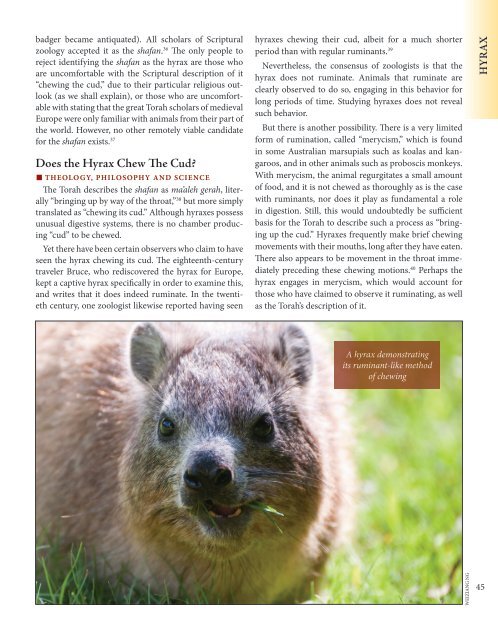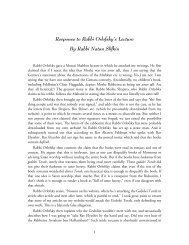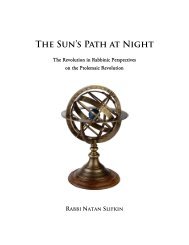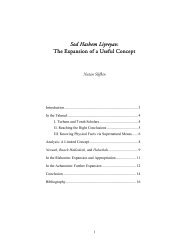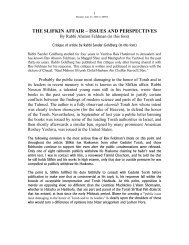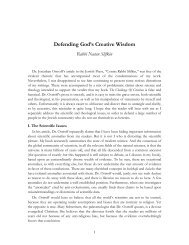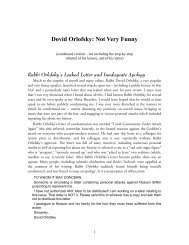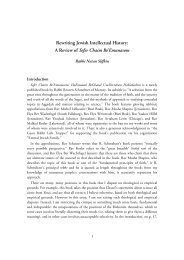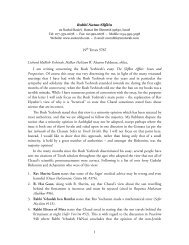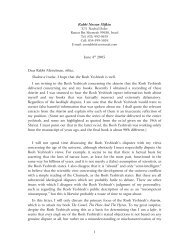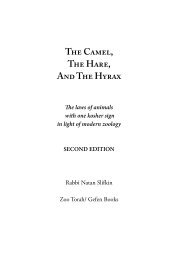OTHER ANIMALS44ALEX KANTOROVICHA hyrax emerging from the safety of its refugeJerboas are rodents, not ruminants, and they are notknown to chew the cud. But it is possible that, like rabbitsand hares, they engage in the process known as cecotrophyor refection. This refers to their reingesting certaintypes of fecal pellets that are specifically produced for thispurpose; we shall discuss this process in more detail withregard to the hare. Many rodents practice such behavior.26 Thus, it is possible that the jerboa practices cecotrophy,and that like the hare, the jerboa would be describedas “chewing the cud” because of this.However, the jerboa cannot be the shafan. Contrary tothe beliefs of Bochart and the other European scholars—who had never seen a jerboa—no species of jerboa makesits home in rocks; all live in tunnels excavated in sand orearth. Furthermore, the <strong>Torah</strong> is only listing behemos andchayos—quadrupeds of reasonable size. Jerboas wouldpresumably be classified as sheratzim, creeping verminouscreatures, which are prohibited from consumption ina different verse. 27 Hence, the jerboa cannot be the shafan.Other writers searched further afield. Some have proposedthat the shafan is the java mouse deer. 28 This is atiny deer that occasionally hides under rocks, just as theshafan is described, and which chews the cud. It is arguedthat since the feet of the mouse deer are splayed, withhooves only covering the extremities, these are rated aspaws with claws rather than cloven hoofs. However, thisidentification is untenable for the same reasons that therabbit is untenable. The shafan is described as a familiaranimal in Scripture and Talmud, whereas the mousedeer is an obscure creature living only in the islands ofIndonesia. The description of the shafan habitually makingits home in the rocks, and mentioned in associationwith ibexes, clearly matches the hyrax far better than themouse deer. If the feet of the mouse deer are not going tobe considered as “split hooves,” then it is more reasonableto propose that we have some additional animals with asingle kosher sign than to propose that the mouse deer isthe shafan of Scripture. But in any case, the feet of mousedeer are not all that different from those of other deer;the part of the foot that touches the ground is entirelysplit, and the extremities are entirely encased by hoof.Still others suggested that the shafan is a member ofthe llama family. 29 However, such animals do not hideunder rocks. 30 Furthermore, they are only native to SouthAmerica, whereas the shafan is described in the <strong>Torah</strong>,Psalms and Proverbs, as well as in the Talmud, as a familiaranimal.The Rediscovery of the Hyrax■ IDENTIFICATIONFor Europeans, the true identity of the shafan wasfirst rediscovered in the eighteenth century by the Britishtravelers Thomas Shaw 31 and James Bruce, 32 whojourneyed throughout the Levant and reported on theplants and animals of the Holy Land. They described thehyrax in detail, for the benefit of their European readerswho did not know this creature, referring to it by itslocal names of daman Israel and ashkoko (“the bristlyone”). They noted that it is clearly the shafan described inScripture: a smallish animal that hides in the rocks and isobserved to chew its cud. Furthermore, the fact that thehyrax lives together with ibex in the same habitat meansthat it is clearly being described in the verse, “The highhills are for the ibex, the rocks are a refuge for the shefanim.”In the nineteenth century, many more first-handstudies were made of the wildlife of the Land of Israel,further spreading the awareness that the hyrax is the shafan.Thus, Rabbi Yosef Schwartz, who wrote a book onthe geography and natural history of the Land of Israelbased on his experiences there, identified the shafan asthe hyrax, giving it the Arabic name of wabr (like RavSaadiah Gaon). 33It took a while for knowledge of the hyrax to spreadthrough Europe; in the nineteenth century, while someaccepted that it is the shafan, 34 others remained unfamiliarwith the hyrax and maintained that the shafan waseither the rabbit or jerboa, working with the mistakenbelief that these animals habitually hide in rocks. Eventually,however, as knowledge regarding all these animalsincreased, it became clear that the rabbit and jerboacould not be the shafan, while the hyrax was an excellentmatch. Thus, in the nineteenth century, Rabbi Meir Leibush(known as Malbim) and Rabbi Dovid Tzvi Hoffmanboth explained that the shafan is the hyrax. 35By the twentieth century, the hyrax was already becomingwell-known (and terms for it such as coney and rock-
adger became antiquated). All scholars of Scripturalzoology accepted it as the shafan. 36 The only people toreject identifying the shafan as the hyrax are those whoare uncomfortable with the Scriptural description of it“chewing the cud,” due to their particular religious outlook(as we shall explain), or those who are uncomfortablewith stating that the great <strong>Torah</strong> scholars of medievalEurope were only familiar with animals from their part ofthe world. However, no other remotely viable candidatefor the shafan exists. 37Does the Hyrax Chew The Cud?■THEOLOGY, PHILOSOPHY AND SCIENCEThe <strong>Torah</strong> describes the shafan as ma’aleh gerah, literally“bringing up by way of the throat,” 38 but more simplytranslated as “chewing its cud.” Although hyraxes possessunusual digestive systems, there is no chamber producing“cud” to be chewed.Yet there have been certain observers who claim to haveseen the hyrax chewing its cud. The eighteenth-centurytraveler Bruce, who rediscovered the hyrax for Europe,kept a captive hyrax specifically in order to examine this,and writes that it does indeed ruminate. In the twentiethcentury, one zoologist likewise reported having seenhyraxes chewing their cud, albeit for a much shorterperiod than with regular ruminants. 39Nevertheless, the consensus of zoologists is that thehyrax does not ruminate. Animals that ruminate areclearly observed to do so, engaging in this behavior forlong periods of time. Studying hyraxes does not revealsuch behavior.But there is another possibility. There is a very limitedform of rumination, called “merycism,” which is foundin some Australian marsupials such as koalas and kangaroos,and in other animals such as proboscis monkeys.With merycism, the animal regurgitates a small amountof food, and it is not chewed as thoroughly as is the casewith ruminants, nor does it play as fundamental a rolein digestion. Still, this would undoubtedly be sufficientbasis for the <strong>Torah</strong> to describe such a process as “bringingup the cud.” Hyraxes frequently make brief chewingmovements with their mouths, long after they have eaten.There also appears to be movement in the throat immediatelypreceding these chewing motions. 40 Perhaps thehyrax engages in merycism, which would account forthose who have claimed to observe it ruminating, as wellas the <strong>Torah</strong>’s description of it.HYRAXA hyrax demonstratingits ruminant-like methodof chewingWEIZIANG NG45


